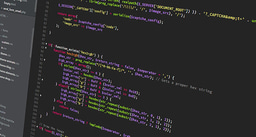How To Choose The Right Pixel Pitch

Pixel pitch is more than just a measurement; it is the foundation for choosing the right display quality. Pixel pitch directly impacts the viewing experience, making it critical to get this selection right. Here is what you need to know about pixel pitch and how it impacts viewing distance and cost.
What is Pixel Pitch?
Pixel pitch, or just pitch, refers to the distance between the centers of two adjacent LED pixels and is measured in millimeters. This measurement is critical because it directly affects resolution and image quality. A 2-millimeter (2mm) pitch LED video wall, for example, has a 2mm distance between the centers of any two adjacent pixels.
Pixel pitch directly impacts several factors, including:
- Viewing distance: This is the distance away from the video wall a person must stand to see images clearly without noticing pixelation. The finer or (smaller) the pixel pitch, the closer the acceptable viewing distance. The larger the pitch, the further away a viewer must be for a good viewing experience.
- Cost: As pitches and viewing distances decrease, pixel density and costs increase. For the best value, it’s essential to know the application's average viewing distance and select the finest pitch required for that application and viewing distance.
- Viewer Experience and Comfort: Proper viewing distance ensures viewers experience consistent image quality without eye strain, which is especially important for extended viewing. A mismatch in pixel pitch and viewing distance can make images appear pixelated or blurry, impacting the overall user experience.
Today, fine-pitch LED video walls are considered to be between 0.7mm and approximately 2.9mm, while standard pitches are considered to be approximately 3 mm and larger.
Learn more about how to calculate pixel pitch with this chat between Yanick Fournier and Jonathan Labbee from Saco.
How to Calculate Viewing Distance
Calculating viewing distance is the first step in choosing the right pixel pitch. Once you understand how far away the viewers will be, you can easily calculate the pixel pitch. In the end, acceptable viewing distance is whatever a customer perceives to be acceptable. There are, however, methodologies used in the industry to determine acceptable viewing distance more objectively:
Visual Acuity Distance
Visual Acuity Distance (VAD), sometimes referred to as “Retina Distance” as popularized by Apple, is a formula that calculates the distance a person with 20/20 vision must move away from an LED video wall to no longer see individual pixels.
VAD can be calculated using the formula:
VAD = Pixel Pitch x 3438
1000
10x Rule
The 10x Rule is a shorthand method for quickly estimating the Visual Acuity Distance for LED displays. The rule suggests you can find the approximate viewing distance by multiplying the pixel pitch by 10. This distance indicates how close a person can be to the screen while seeing a clear image.
For example, if the pixel pitch is 2mm, the ideal viewing distance would be approximately 2 mm times 10 = 20mm or 2 meters.
Average Comfortable Viewing Distance
The Average Comfortable Viewing Distance (ACVD) is the estimated viewing distance at which most people will find the video wall’s appearance acceptable. This estimation is based on a large number of real-world installations. The ACVD is subjective and can be impacted by a person’s eyesight, resolution of content, and type of content (e.g., video vs. spreadsheet).
The general formula for ACVD is:
ACVD = Pixel Pitch×30
Viewing Distance Chart
This Viewing Distance Chart lists the calculations for Visual Acuity Distance and Average Comfortable Viewing Distance related to pixel pitches from 0.7mm to 10mm.
| Pixel Pitch(millimeters) | Visual Acuity Distance(feet / inches | meters) | Average Comfortable Viewing Distance(feet / inches | meters) |
|---|---|---|
| 0.75mm | 8ft 6in | 2.58m | 4ft 3in | 1.29m |
| 1.00mm | 11ft 3in | 3.44m | 5ft 8in | 1.72m |
| 1.25mm | 14ft 1in | 4.30m | 7ft 1in | 2.15m |
| 1.50mm | 16ft 11in | 5.16m | 8ft 6in | 2.58m |
| 1.75mm | 19ft 9in | 6.02m | 9ft 11in | 3.01m |
| 2.00mm | 22ft 7in | 6.88m | 11ft 3in | 3.44m |
| 2.25mm | 25ft 5in | 7.74m | 12ft 8in | 3.87m |
| 2.50mm | 28ft 2in | 8.60m | 14ft 1in | 4.30m |
| 2.75mm | 31ft 0in | 9.45m | 15ft 6in | 4.73m |
| 3.00mm | 33ft 10in | 10.31m | 16ft 11in | 5.16m |
| 4.00mm | 45ft 1in | 13.75m | 22ft 7in | 6.88m |
| 5.00mm | 56ft 5in | 17.19m | 28ft 3in | 8.60m |
| 6.00mm | 67ft 8in | 20.63m | 33ft 10in | 10.31m |
| 7.00mm | 78ft 11in | 24.07m | 39ft 6in | 12.03m |
| 8.00mm | 90ft 3in | 27.50m | 45ft 1in | 13.75m |
| 9.00mm | 101ft 6in | 30.94m | 50ft 9in | 15.47m |
| 10.00mm | 112ft 10in | 34.38m | 56ft 5in | 17.19m |
Frequently Asked Questions about Pixel Pitch
To understand pixel pitch, it's also important to understand other related concepts. Below, you'll find the answers to commonly asked questions about pixel pitch and similar concepts like PPI and resolution.
Is a higher or lower pixel pitch better?
There is no right or wrong pixel pitch. The right pixel pitch depends on the viewing experience. For example, if you're creating an outdoor LED wall that will be viewed from a distance, a higher pixel pitch will be sufficient. However, for a video wall in a conference room where executives sit at a table a few feet away, you'll want a lower pixel pitch to improve the viewing experience.
What is the best pixel pitch?
The best pixel pitch is based on the desired viewing experience. A larger pixel pitch is better for screens that will be viewed at a distance, while a smaller pixel pitch is ideal for screens that will be viewed at closer distances, such as in a small conference room.
Is pixel pitch the same as resolution?
No, pixel pitch and resolution are not the same, though they are related. Pixel pitch refers to the distance between the centers of two adjacent pixels in a display and is generally measured in millimeters. Resolution refers to the total number of pixels that make up a display and is typically measured in width versus height—for example, 1920 x 1080. Pixel pitch contributes to resolution when combined with screen size. For instance, a larger screen with a small pixel pitch will have a higher resolution than the same size screen with a larger pixel pitch.
What is pixel pitch vs PPI?
Pixel pitch and PPI (pixels per inch) are both metrics that describe pixel density, but they measure different aspects and are used for different types of displays. Pixel pitch is the distance in millimeters between two adjacent pixels and is generally used for LED displays like video walls. PPI measures pixel density within a single inch of a display and is usually used for small displays such as computer monitors or smartphones.
Final Thoughts on Pixel Pitch
Understanding pixel pitch and how it relates to the viewing experience is crucial when choosing an LED display. Selecting a lower pixel pitch than necessary can result in higher costs with little to no performance gain. However, choosing a higher pixel pitch can result in a screen that is difficult to see from the preferred viewing distance. With the right pitch, your display will deliver a clear, sharp image that is tailored to your audience's needs.






Please sign in or register for FREE
If you are a registered user on AVIXA Xchange, please sign in